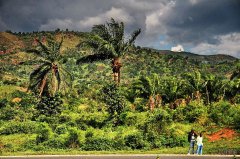Rich flavor, mild taste, Port-au-Prince, Haiti coffee
Most of the coffee produced in Haiti is grown in a purely natural state, which is not intentional but the result of material shortages because coffee farmers are too poor to buy fungicides, insecticides and fertilizers. On the contrary, this makes the coffee produced in Haiti the most natural and pollution-free. Haitian coffee is full-grained, rich in flavor, medium to low acidity and mild in taste. In Japan, Haitian coffee is often mixed with Jamaican Blue Mountain Coffee, thus making Blue Mountain Coffee more full-bodied, known as Blue Mountain's good companion flavor features: rich flavor, mild taste.
Haiti, located in the western part of Hispaniola Island in the Lobi Sea, covers an area of about 27800 square kilometers. "Haiti" means "mountainous country" in the indigenous language. This mountainous country is also the most disaster-prone region on earth, it has been in the midst of war and poverty, and it is one of the most material-poor countries in the world. Even so, it can't stop this country from having the gift of nature. The biggest export of Haiti, which occupies 2 to 3 of the western island of Hispaniola, is coffee.
In 1725, Haiti officially began to grow coffee in the north, and now produces and exports about 600000 bags of coffee a year. Unfortunately, even in the final selection stage, Haiti does not distinguish between the quality of coffee beans on each farm. Coffee beans are mixed with the good and the bad. General Haitian coffee, mainly exported to European countries, led by France, is used to make blended coffee.
However, there is another part of the coffee, which is carefully planted in the high mountains and then refined. Most of these coffees are called "SHG Coffee" (meaning coffee grown above 1600 meters above sea level), and some are called "Port-au-Prince Coffee" and "Blue Haitian Coffee". These coffees are famous and expensive.

Important Notice :
前街咖啡 FrontStreet Coffee has moved to new addredd:
FrontStreet Coffee Address: 315,Donghua East Road,GuangZhou
Tel:020 38364473
- Prev

Zimbabwe's top coffee beans are mainly produced in the cities of Chipinge and Mu
Zimbabwe (Zimbabwe) aroma 3% brightness 4% mellow 3% flavor 4% aftertaste 4% suitable for baking degree: City/Full City City to Full City, but the flavor will be more complete under Full city baking, it is recommended to leave it for three or four days before tasting. Zimbabwe could not grow coffee until the 1960s, but it already has good quality, balance and recovery.
- Next

Introduction of Peruvian organic coffee with high quality and balanced acidity
Flavor and taste characteristics: high-quality and balanced, palatable acidity, can be used for mixed drinks, Peruvian coffee does not have a long history, but as a rising star, Peruvian coffee is gradually opening up its popularity and entering the world. Peru is located in western South America, with a coastline of 2254 kilometers. The Andes runs from north to south, and the mountains account for 1% of the country's area. it belongs to the tropical desert region and has a dry climate.
Related
- Does Rose Summer choose Blue, Green or Red? Detailed explanation of Rose Summer Coffee plots and Classification in Panamanian Jade Manor
- What is the difference between the origin, producing area, processing plant, cooperative and manor of coffee beans?
- How fine does the espresso powder fit? how to grind the espresso?
- Sca coffee roasting degree color card coffee roasting degree 8 roasting color values what do you mean?
- The practice of lattes: how to make lattes at home
- Introduction to Indonesian Fine Coffee beans-- Java Coffee producing area of Indonesian Arabica Coffee
- How much will the flavor of light and medium roasted rose summer be expressed? What baking level is rose summer suitable for?
- Introduction to the characteristics of washing, sun-drying or wet-planing coffee commonly used in Mantenin, Indonesia
- Price characteristics of Arabica Coffee Bean Starbucks introduction to Manning Coffee Bean Taste producing area Variety Manor
- What is the authentic Yega flavor? What are the flavor characteristics of the really excellent Yejasuffi coffee beans?

